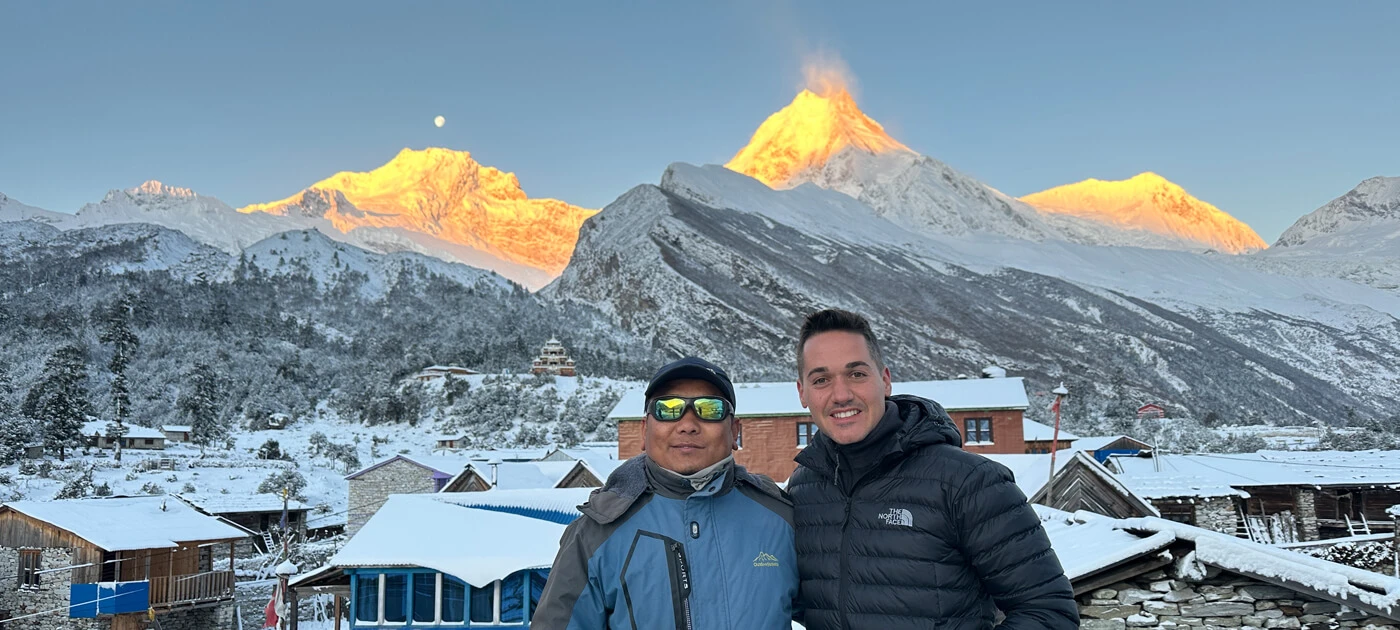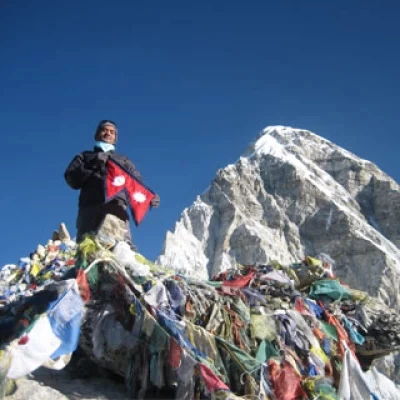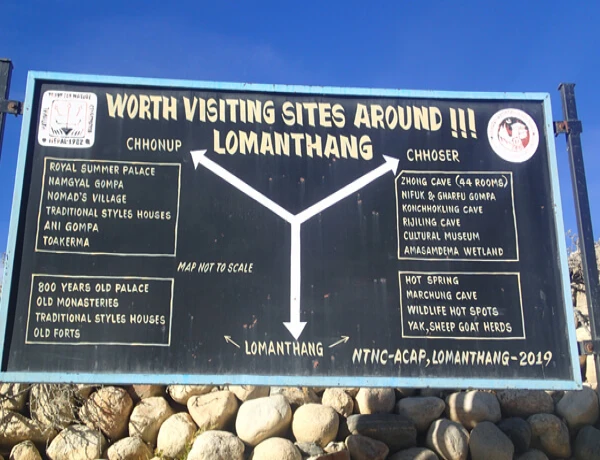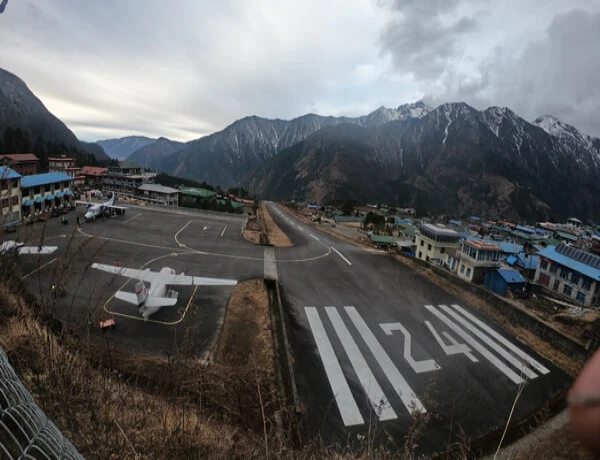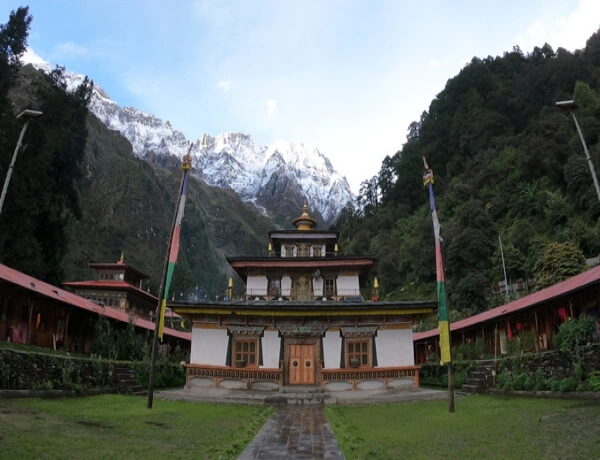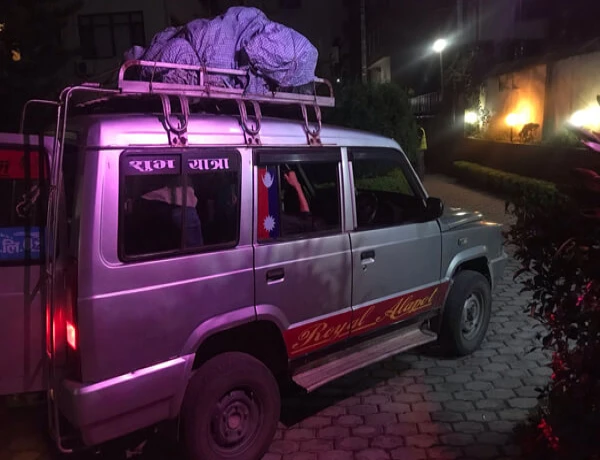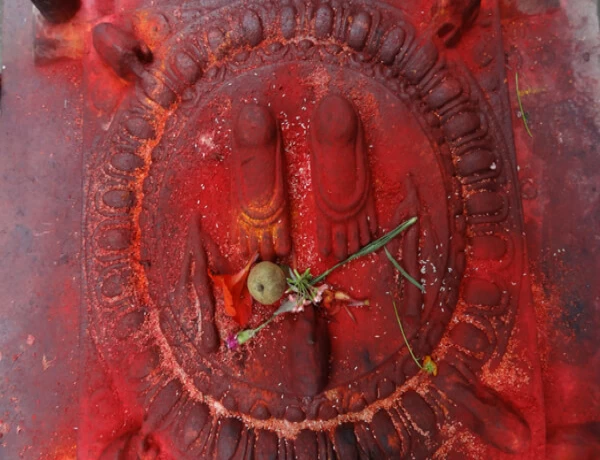Embark on the Ultimate Adventure: Your Comprehensive Guide to the Manaslu Circuit Trek with Tsum Valley! The mysterious and spectacular four hidden lands—Kyimolung, Dhemajung, Pemaque, and Khempalung—stretching from the eastern Kanchenjunga to the western Api Mountains, are revered as some of the world’s most sacred, austere, and spiritually profound regions, rich in religious, cultural, and historical significance. KYIMOLUNG: Hidden Valley of Happiness in Tusm Nubri Valley at Manslu.
Complete Guide to Manaslu And Tsum Valley Trek Trail Update After Montha Cyclone for Your Best experience
Lamjung, A Complete Guide to Manaslu Circuit and Tsum Valley Trek provides information that will help you to find updated information throughout the entire trip. If you are here, then you have heard praises of the beauty of the Manaslu region. Discover the sensation of traversing the world's 8th-highest mountain. Here, we have provided comprehensive guidelines to help you prepare for your trek. Are you planning to go trekking in the Manaslu region?
Would you like to go trekking in the Manaslu region? Excellent choice. The Manaslu Circuit Trek with Tsum Valley encircles the world's 8th highest mountain, Mt. Manaslu (8,163 m), and leads to the hidden valley of Tsum.
Manaslu Circuit Trek Trail Update after Montha Cyclone – Latest Condition Report
Trail Condition Update (1st November 2025):
The powerful Montha Cyclone has recently impacted the Manaslu Circuit Trek, temporarily disrupting parts of the route. Due to safety concerns, the local police in Arughat Bazaar are currently not allowing trekkers to proceed beyond the checkpoint. Several trekkers have been stuck in Machhakhola and Jagat for the past few days, as continuous rainfall caused landslides and trail blockages between Jagat and Pewa.
According to our trekking guide Rabindra Tamang on the ground, the weather is slowly improving. In Shyala village nearbySamagaun, the skies are clearing, and two groups have already started from Samdo toward Dharmashala today. Sunshine has returned to the upper region, and if the weather continues to improve tonight, the Larkya La Pass (5,106 m) might reopen soon.
Likewise, our next Guide Narayan Thapa Magar (Pratap) who is in Tsum Valley at Chumling today, went back from Mu Gumba, Chhekamparo. The trail of Tsum Valley is good and safe for the trek.
In Kathmandu, the weather has turned sunny, giving us hope that the Manaslu trail will reopen safely within a day or few days.
However, for trekkers on tight schedules, it might be wise to switch to the other trekking region; Langtang, Annapurna region — such as the Ghorepani–Poon Hill–Tadapani–Ghandruk–Hot Spring–Chhomrong–Landruk–Mardi Himal route. Or Annapurna Base camp Trek Via Poon hill.
The Annapurna area is currently safe and open, and you can even use your existing ACAP permits from Manaslu — no extra permits needed!
Trail Condition Update (2nd November 2025):
The local government of the Gorkha Tsum Nubri rural municipality lifted restrictions for the Manaslu Circuit Trek trail after the weather improved. Trekkers who encountered difficulties at Jagat and other locations are now making their way to the Manaslu Circuit Trek, utilizing alternative routes. So, if you are looking for the Manaslu Circuit trek, you can go ahead.
Your safety is always the top priority. The mountains may test your patience, but they always reward your spirit. Sometimes, a small delay leads to the most beautiful sunrise. Stay positive, stay connected, and we’ll keep you updated on every step of the Manaslu trail recovery.
Manaslu Circuit Trek is doable in winter, especially in December
Is the Manaslu Circuit Trek in December? Is Larkya La Pass open during winter? What is the status of the tea houses located in Samdo, Dharmashala, and Bhimtang? Is it opening?
The Manaslu Circuit Trek is doable in December, but it comes with extra challenges due to weather and logistics. Here is a comprehensive breakdown:
Safety of the Manaslu Circuit in December.
Stay informed about trial situations and be flexible with your itinerary.
Weather Conditions: December occurs in the early winter season in Nepal. The sky typically appears clear, offering breathtaking mountain views. Temperatures can decrease dramatically, especially above 3,500 meters, with sub-zero conditions at higher levels. Snowfall is possible, especially around Larkya La Pass, which could make the journey more challenging. While the early half of the month frequently offers calm weather with sunny skies, it also brings chilly temperatures, especially at higher places like the top of Larlya La Pass. In areas like Dharmashala and Larkya La Pass, temperatures at night can drop to -20°C or below.
Temperatures: During December, daytime temperatures at lower altitudes (700-2,000 m) vary from 5 to 15 degrees Celsius. At higher elevations (over 4,000 m), temperatures drop significantly, ranging from -10°C to -20°C at night and early morning.
Snowfall occurs more frequently in winter, particularly at Larkya La Pass. Fresh snow could make pathways slippery and hide routes.
Wind Chill: Strong winds near the pass can lower the felt temperature and make trekking challenging. Prepare with warm trekking garments for facing it.
Trail Conditions: Trails may be snow-covered, especially when approaching the Larkya La Pass (5,160 m) on both sides. This might make walking harder and increase the possibility of falling or losing the way in poor weather.
Altitude sickness: Same as other times of the year. Acclimatization before heading up the pass at a steady pace and keeping hydrated is important. Though it is cold, preparing your hiking gear for the winter and eating nourishing foods may help minimize the danger.
Larkya La Pass Accessibility:
The Larkya La Pass (5,106 m) is often accessible in early December unless severe snowfall blocks the trail. Nepal Mother House Trek will talk with locals about route circumstances and tea houses. We will monitor situations on an ongoing schedule and advise whether or not crossing is doable. Crossing the pass must start early in the morning to avoid strong winds and, most likely, weather changes.
Tea House Available in December:
The teahouse will remain open year-round until Samagaun. However, Samdo, Dharmashala, and Bhimtang may only be open during trekking season. Nevertheless, certain staff members will be responsible for maintaining the home and teahouse throughout wintertime.
Samdo (3,875 meters) is a significant acclimatization stop. Teahouses here often open in early December to cater to trekkers. However, between mid-December and mid-February, some tea houses may close due to a decrease in the number of trekkers and the extreme cold.
Recommendation: Before beginning the Manaslu Circuit journey, we will verify information with locals.
Dharmashala/Larkya Phedi (4,460 meters): The tea house rooms in Dharmashala remain open until mid-December, but they may close if snow falls and temperatures drop. Availability can also be based on the number of trekkers trying the route. If the tea house in Dharmashala remains closed, you can request the hotel owner in Samagaun to reopen it.
Risk: If the tea house shuts, camping may be the only other option, requiring particular gear and essential meals.
Bhimtang: Bhimtang (3,720 m) is an important stop after crossing the Larkya La Pass. Tea houses in this area are frequently open in December to assist trekkers descending into Dharapani. However, contact them first to confirm its opening. If not, we need to prepare in advance by packing some food and plenty of drinking water. We can find a teahouse at Goa/Gho (2515 m) after a 3- to 4-hour hike from Bhimtang.
Tips for Trekking in December:
- Hire a Guide or Porter: A guide can provide updated information on the route and weather conditions, ensuring safety.
- Altitude Medication: Pervasion is more efficient than a cure for altitude medication! However, carry altitude sickness medicine and practice suitable acclimatization.
- Proper Gear: Bring warm, layered clothing, high-quality sleeping bags for temperatures below -20°C, crampons for ice routes, and gaiters.
- Confirm Accommodations: Call ahead to confirm tea house openings, especially in Samdo, Dharmashala, and Bhimtang.
- Acclimatization: Although there are fewer trekkers, thorough acclimatization is still essential for avoiding altitude sickness.
- Permissions: Ensure you have the necessary trekking permits for the restricted Manaslu region, including local government, ACAP, and MCAP, which your trekking organization may provide.
- Emergency Planning: Ensure journey insurance covers high-altitude excursions and helicopter evacuation. Likewise, provide your relatives and friends' emergency phone numbers in case they are required.
With proper planning, December may be an ideal time for the journey, with tranquil scenery and fewer visitors. Don’t forget to consult with local trekking companies or guides for the most up-to-date circumstances.
Is the Manaslu Trekking Trail still secure following the heavy rainfall that occurred on September 27, 2024?
The Manaslu Trekking Trail remains safe for trekking following the huge rainfall that occurred on September 27, 2024, all over Nepal. The road to Machhakhola is open for travel on 30th September 2024, according to the Kathmandu bus ticket counter. Additionally, the rain has not affected the trekking trail itself, and the bridges are suitable for walking. The trail is accessible, and the Larkya Pass (5,106 meters) is open for traversing, according to reports from Nepal Mother House Guides in Sama Gaun and Bihi Phedi. Several trekkers and mules are presently crossing the route from Bhimtang to Samagaun via Larkya Lapass. The trail is in remarkable condition for your adventure. If you have been planning the Manaslu Circuit and Tsum Valley or the Manaslu Circuit Side Trek, like visiting Serang Gumba while on the Manaslu Circuit Trek for your spiritual awakening,Prok Village,Kaltal, Manaslu Base Camp, Phungen Gumba, and Ruila Pass at the Tibet border, you can tie up your shoes less for your journey!
Do you know?
Manaslu is derived from the Sanskrit word ‘Manasa,’ meaning ‘intellect’ or ‘soul.’. Also, the mountain is called “Mountain of the Spirit." Locals call it ‘Kang Pungyen’ because it is above Pungyen Gompa.
The Manaslu Circuit Trekking route is spread over 230 kilometers (143 miles) in the remote northern part of Nepal to the Tibet border, gaining a maximum elevation of 5106 meters (16929 feet) at the top of the Larke La Pass, then down to the Annapurna Circuit Main Trail at Dharapani.
If you are planning to trek in the Manaslu region, then your main reason might be fewer crowds and astounding beauty. Plus, it has different characteristics than any other trekking trail. In addition to Tsum Valley, you might want to spend the rest of your life in the Himalayas.
Manaslu Circuit and Tsum Valley Trek Highlights.
- Walk around the 8th highest mountain, Mt. Manaslu.
- There are fewer crowds and a peaceful environment.
- Discover the hidden beauty of Tsum Valley.
- Experience the Tibetan-influenced Buddhism.
- Visit numerous Buddhist pilgrimages like monasteries, Gomba, Chorten, and Manes.
- Diverse ethnic groups share unique customs, cultures, and traditions.
- There is a panoramic view of Mt. Manaslu, Shringi Himal, Ganesh Himal, and many more.
- The opportunity to witness endangered species is truly unique.
Manaslu Circuit and Tsum Valley Trek Summary.
Max Elevation: 5,106 meters.
Lowest Elevation: 535 meters.
Total days: 18-25 days.
Total distance: 230 kilometers.
Starting point: Soti Khola/Machha Khola.
Ending point: Dharapani.
Duration: 18-26 Days
Accommodation: Tea houses/lodges.
What is the best time to visit the Manaslu Circuit and Tsum Valley?
The best seasons to visit the Manaslu Circuit and Tsum Valley are autumn and spring. Autumn is after the monsoon season, while spring is before the monsoon. But it doesn't mean that other seasons are not suitable; it is just complicated.
Therefore, we have a brief description of the seasons in Nepal for your best experience:
Spring (late February to early June): Spring is one of the best seasons to trek because it has pleasant weather. Additionally, blooming rhododendron flowers decorate the forests. You might see remaining snow on the route from the winter season.
Monsoon (early June to late August): It is the rainy season. So, you will face light to heavy rain along the route. It has the potential to dampen your belongings and create mud on the trail. Also, the weather gets cloudy and blocks all the views.
Autumn (late August to late November): Hands down, this is the best season to trek in Manaslu. The weather is clear and calm. The view is stunning, as always.
Winter, which spans from late November to late February, typically brings consistently cold weather to higher elevations. However, winter brings with it an even greater chill. However, the sky is clear, and the view gets awesome. However, once snowfall commences, the trail will remain closed until spring.
This is just short information. If you want to learn more, just check out our Best Time to Visit Nepal.
Where do we start and end the trek?
Generally, the Manaslu trek begins in Arughat and ends in Besisahar.
Nowadays, the trek starts from Sotikhola Machhakhola or Jagat. It depends on where you want to start your trek. Now, road access has reached Jagat.
Likewise, the Manaslu trek ends in Dharapani a couple of days after crossing Larke La Pass. From there, you take a Jeep to Besisahar and then again to Kathmandu.
The Manaslu Circuit and Tsum Valley Trek require specific permits and associated costs.
It is most important to know about Nepal trekking permits and fees before choosing the trip. As the Manaslu Circuit and Tsum Valley are in a restricted area, special permits are required for this trek. MRAP (Manaslu Restricted Area Permits), MCAP (Manaslu Conservation Area Permit), ACAP (Annapurna Conservation Area Permits), TIMS (Trekkers Information Management System) card, a special permit for Tsum Valley, and Tsum Nubri Rural Municipality local government fee.
Likewise, recently, the local government of Tsum Nubri Rural Municipality in Gorkha has declared that it will start collecting fees for both international and domestic tourist visits to the Manaslu Conservation Area (MCA).
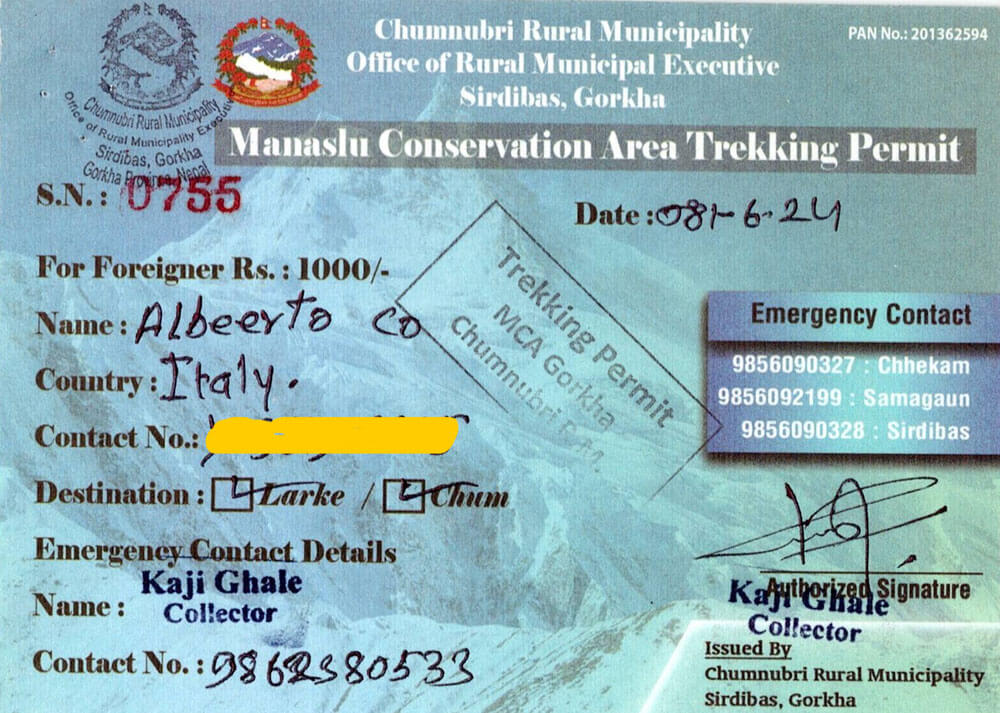
According to the President of the Tsum Nubri Rural Municipality, Mr. Nima Lama, the decision was taken on September 6th, 2024, with the local stockholders of Tsum Nuri, political parties, tourism entrepreneurs, and experts.
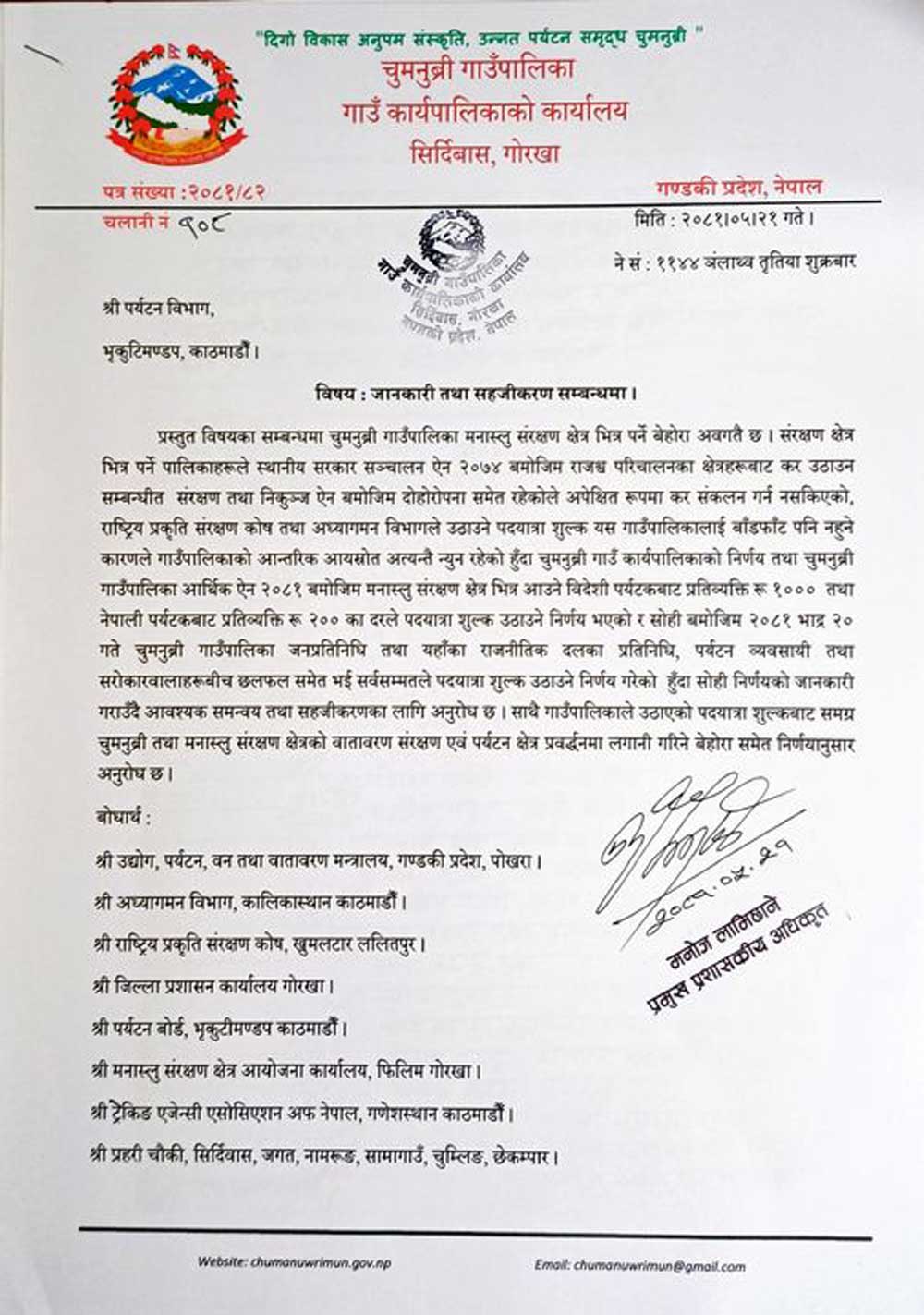
The chief administrative officer, Manoj Lamichhane, said that based on the Financial Act 2081, international visitors need to pay a fee of Rs 1,000, while Nepali tourists will be charged Rs 200 per person. This fee will be invested for the environmental conservation of Chumanuwri and the Manaslu Conservation Area; this helps to empower the locals for sustainable tourism in the region, whereas the fee that has been collected from visitors was not divided among the local stockholders by the Department of Immigration and the National Trust for Nature Conservation.
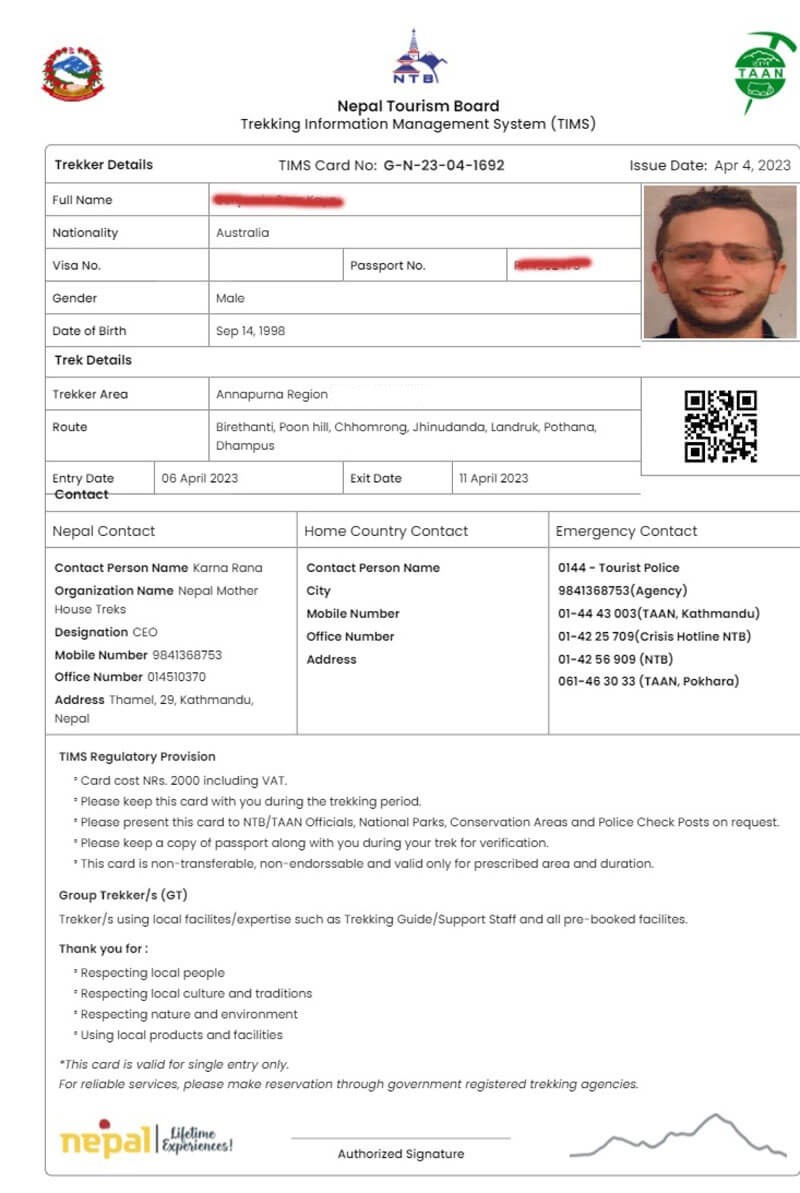
The MRAP allows for travel from Jagat to Samagaun. You can obtain it from the Department of Immigration. It costs $100 per person for a week and $15 per day for additional days from September to November. In the remaining months, it costs $75 per person for a week per day and $15 for additional days.
The Nepal Tourism Board provides MCAP and ACAP. MCAP costs $2 for SAARC countries and $20 for other countries. Likewise, ACAP costs $30 and $2 for the SAARC nations.
TIMS cards are available from the TIMS counter at TAAN. It costs $10 for every nation, while FITs (Free Individual Travelers) cost $20. We only check it on the final day of the trek, so it's not a requirement. But I recommend you make it a trouble-free trip. The Department of Immigration also issues a special permit for Tsum Valley. Likewise, from September to November, it costs $40 per person for a week and, per day, $7 for additional days. In the remaining months (December to August), it costs $30 per person for a week and $7 per day for additional days. For more details, you will find every detail of trekking permits and fees on the Nepal Government's authorized website.
Documents Required for the Manaslu Restricted Area Trekking Permits
- Only government-authorized agencies can apply for the Manaslu restricted area trekking permits (Manaslu RAP) along with the following documents:
- Online application form (trekkers) Link to Trekking Permit Application
- The trekker must provide a copy of their passport and a valid visa for the entire trek.
- The day-to-day trekking program schedule is provided with a specific date.
- A Guarantee Letter of Agency to the Government of Nepal Ministry of Home Affairs Department of Immigration
- Name lists of trekkers, guides, and other staff.
- A guide and other staff members who are insured (NPR 10K) mention names while filling out the online form.
- Tax clearance Certificate of Trekking Agency
- The Ministry of Tourism, Culture, and Civil Aviation issued a license to run a trekking business.
- The exchange of foreign currencies is legal thanks to a license from Nepal Rastra Bank.
- Registration Certificate of Permanent Account Number (PAN) or Value-Added Tax (VAT) Certificate
- Domestic and small industries license documents of Agency
- Company Registration Document of Agency
- Voucher of Bank payment (fees in USD) for permits
- Each trekker has a COVID-19 vaccination card.
- Need the original passport of trekkers while buying a Manaslu Restricted Area Trekking Permit.
What are the terms and conditions of the Manaslu Trek permit?
- The Manaslu permit is non-refundable and can’t be transferred.
- A permit is valid for single entry only.
- There should be a minimum of two trekkers required in a group.
- Individual trekkers and freelance guides are strictly forbidden in the restricted areas.
- Trekkers must adhere to a special permit, which prohibits them from changing the trekking route. The concerned trekking agency/trekking guide accompanying the group must not let trekkers change the route.
- The trekking agency must provide daily expenses, safety gear, appropriate clothes, and personal accident insurance for the guide, porter, and other staff. Finally, we need a professional local guide from the Trekking Agency.
- Under 10 years, children don’t need Manaslu Restricted Area Permits.
- An authorized agency must process the Manaslu Restricted Area Permit (Manaslu RAP).
- When in Rome, do as the Romans do; trekkers should respect local customs and traditions and must follow the norms and culture of the society.
- Trekkers shall abide by the National Park and Wildlife Conservation Act of Nepal, 2029 BS/1973 AD.
- Each checkpoint along the trek must display the permits.
- ACAP and MCAP permits will be issued only from the Nepal Tourism Board Office at Kathmandu and Pokhara, not at any checkpoints in the trek. However, the ACAP permit is also available at Besisahar, Lamjung, at the same cost.
- The Manaslu Restricted Area Permit (Manaslu RAP) is only issued by the Immigration Department, Anamnagar, Kathmandu, and Pokhara.
- Trekkers who are going on an expedition/peak climbing through the restricted area do not need to pay for restricted area permits after getting expedition permits.
- Permit fees include all taxes.
Why is an ACAP permit needed for the Manaslu Trek?
Manaslu Trek is a combination of two different conservation areas: ACAP and MCAP. It needs the Annapurna Conservation Area Project (ACAP), even for 1 or 2 days at the end of the trip. The Manaslu Trek itinerary includes the routes of ACAP, such as Dharapni and Larkya Pass Top.
The Sacred Tsum Valley and its Facts
Even if people are not drinking alcohol, every house stores alcohol the whole year to serve the guests. Human life necessitates alcohol for everything from birth ceremonies to funerals, and even beyond all festivals, such as Pujal, it is essential in human life; it is needed from the fact that every year, when someone falls ill, relatives also bring liquor to ease their discomfort.
Tsum Valley has the synonym of Saga (Non-Violence)
In this sacred valley, you cannot. If an individual inadvertently ignites a fire in the jungle, the village community will impose a penalty of Rs. 50,000.00, resulting in the death or harm of numerous creatures such as insects, grasshoppers, mice, birds, and other animals. The village community will receive Rs. 50,000.00, resulting in the death or harm of numerous creatures such as insects, grasshoppers, mice, birds, and other animals. The accused person has to offer 108 oil lights (Diyo) as an apology for this unknown mistake and bad karma to vow not to make a mistake in the future. Some trekkers have to be careful while visiting the sacred Tsum Valley. If you are a segregated lover, be careful after smoking with fire.
There is no way to kill animals at Tsum Valley, although there is no bar to eating meat.
Kill animal is strictly provided in the region; however, some people are having meat that is carried from downtown. Inadvertently, animals such as yaks and goats that graze in the pasture, fall off a cliff, or experience other accidents can also be consumed.
Likewise, Tsum Valley is provided:
- To Keep the Honey Bee
- To keep the Chicken farm
- No Violence, No shelter animal
- No firing in the Jungle
People's culture and Lifestyle till 2009 in Tsum Valley
Tsum Valley has been open since 2009 for foreign tourists. Hidden in the shadow of the lamp, Tsum Valley holds immense tourism potential. Given its proximity to the Tibet-China border, this trek operates as a restricted area, subject to specific rules and regulations. The remote Himalayas isolate people from the outside world.
People rarely wash their heads once a week and only take a whole-body bath once a year during the special Losar (New Year) season. Nature is so kind to take care of everybody's health.
Farming and animal husbandry were the main occupations of the Tsum Valley before tourism flourished.
Onetime farming in the year, like potatoes, wheat, barley, buckwheat, and mustard, the main crop of the valley, and keeping the animals like yaks, horses, and sheep.
They grow barley and wheat regularly for three years; after that, buckwheat or mustard for one year. Likewise, the cycle of group planting continues.
Yeks Header and his salary
There is a certain herder, known as Leba, who tends to his animals and oversees all the towns. He grazes the cattle on pasture land, brings them home, and ensures their safety throughout the year. The villagers provide a specific amount of grain, such as wheat, barley, potatoes, rice, or any other grain, to the laborers who care for the cattle.
Ancient Buddhists handwrote the Grantha with gold and silver sculpture
Gold and silver handwritten sculptures and precious holy books can be found in the Tsum Valley, specifically in the house of Tashai Tundup. Due to the safety concern, everybody cannot see this precious book. Only a key person can view this sacred book.
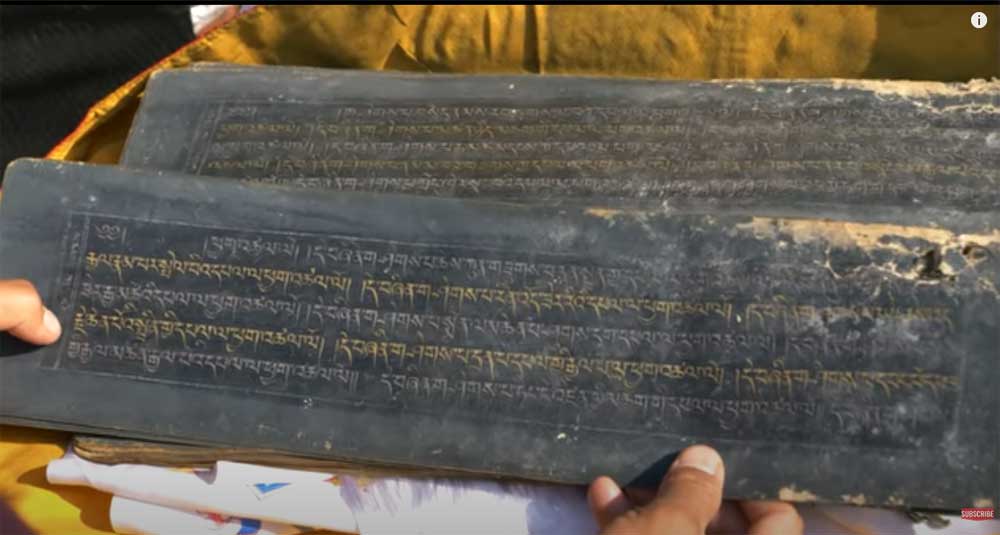
Tsum Valley is an open museum dedicated to animals and culture.
People here are Tsumba; their culture is similar to the Tibetan people, and they follow Buddhism. There are century-old monasteries, Chhorten, Mane Wall, and Buddhist Mantra craving rock and stone.
Among the sons is one in charge of looking after the family
According to the local rule, if there is only one son in the family, he must stay with the family, taking care of them. One son has to stay behind to look after their household. The tradition here at Tsum Valley is that a single son cannot leave home. He needs to take care of the property. The only son has to take over the property. He cannot go aboard. But it is up to you whether you accept it or not.
Nowadays, even people are ready to reduce the number of meals to provide children with education. We were not getting an education in our childhood.
Married women dress and tradition.
Married women are required to wear the amdung (dress) as part of the Tsum Valley tradition.
The second child, aged 6 to 8, must live in Gumba as an Anni (nun) or monk. Rachen Gumba and Mu Gumba have access to a large number of Buddhist students. If anyone likes to leave, it is possible at a certain age to support the family.
Ornament
Women wear an elephant tusk bracelet (Falak). They have preserved this for a while. The mother-in-law inherited this from her mother-in-law.
The Tibet border is not far away.
Above this are the Mu Gumba, then Yak pastures, and Tibet Border. For the locals who can walk at a fast pace, the journey takes approximately 4 to 5 hours. The beauty of the place is enhanced from a higher altitude. Locals can travel to Tibet with only a border identity card; no passport or visa is required. They stamp according to how many days we are there for. Kerung in Tibet can be from Tsum Valley.
Place for Biodiversity
Many Himalayan thar can be seen grazing in the pastureland near the trail. Other animals like thorns and musk deer have no horns, but males have tusks like elephants. The males have tusks facing outwards. After February/March (Fagun month), the snow melts quickly. Before that, it takes a long time for the snow to melt. This is a common occurrence during the winter season. The soil is very cold. In spring, you get a lot of birds; in winter, they migrate to the south. In spring, you can hear them singing. And it is green wherever you look. There are a lot of Dahpe (Nepal’s national birds). This is a beneficial place for biodiversity. Jharal (Thar), Naur, Daphe, Kasturi, and Mirga (deer). There are also snow leopards (Sarken in the local language) and wolves. There are snow leopards in the vicinity. I met one there the other day. It eats yaks and gnaws.
You can find priceless herbs in this area, such as Yarsagumba; the best time to harvest them is from April to May.
Tibetan Salt as inherited land property
Salt is brought from Tibet for daily use by yaks and humans by the grandfather and handed over to the son as inheritance property.
Why is the Manaslu Region a restricted area?
The Manaslu region is not as popular as the Everest and Annapurna regions. But it holds its distinct culture, tradition, religion, norms, and values. We have listed it as a restricted area to protect its unique culture and tradition. Plus, it helps to increase the living standard of people.
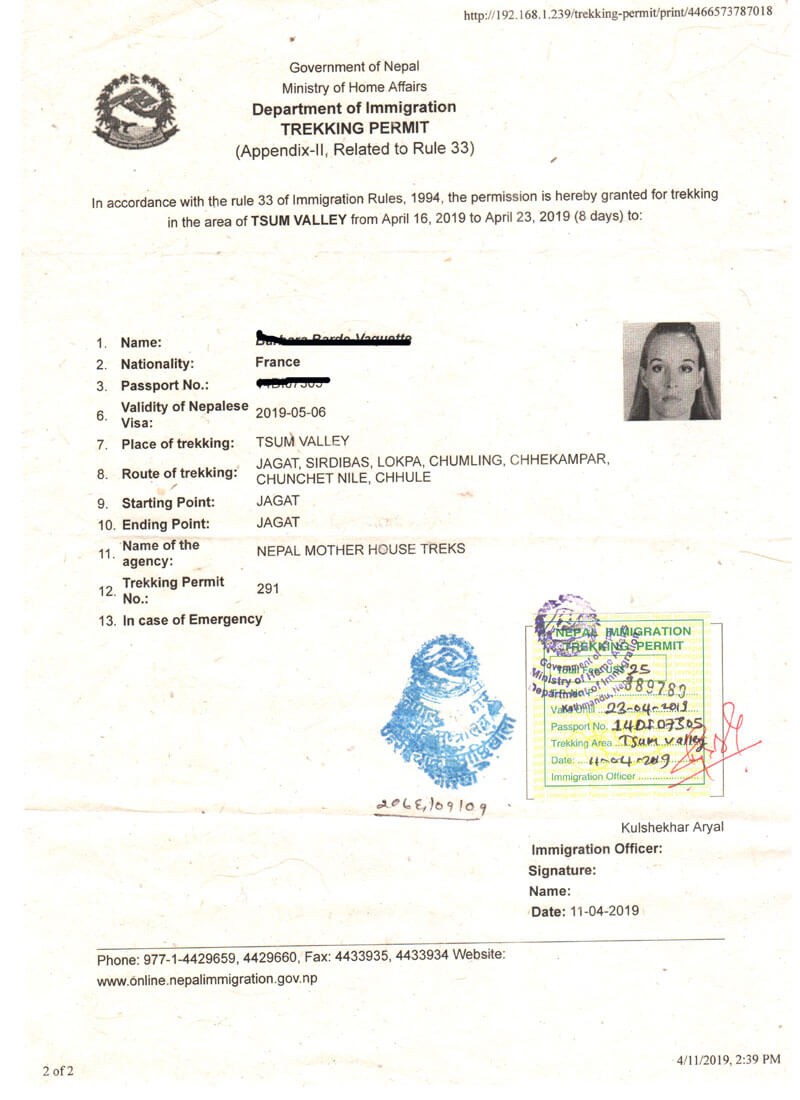
The Manaslu region, particularly the upper Manaslu, maintains its isolation from the modern world. Additionally, the trekking trail extends throughout the rural areas of the Manaslu Conservation Area. These rural areas are characterized by uncertainty. Therefore, we have classified it as a restricted area to ensure your safety. Likewise, this is a sensitive area for political issues due to the nearby Tibet border.
Manaslu Conservation Area.
Manaslu Conservation Area is a protected area located in the autonomous part of Gorkha. Established on December 28, 1998, the Manaslu Conservation Area spans 1,663 sq. km. and encompasses the Mansiri Himalayan Range. It was the second conservation area under the National Trust for Nature Conservation (NTNC). The altitude of this protected area rises from 600 meters to the summit of Manaslu—8,163 meters.
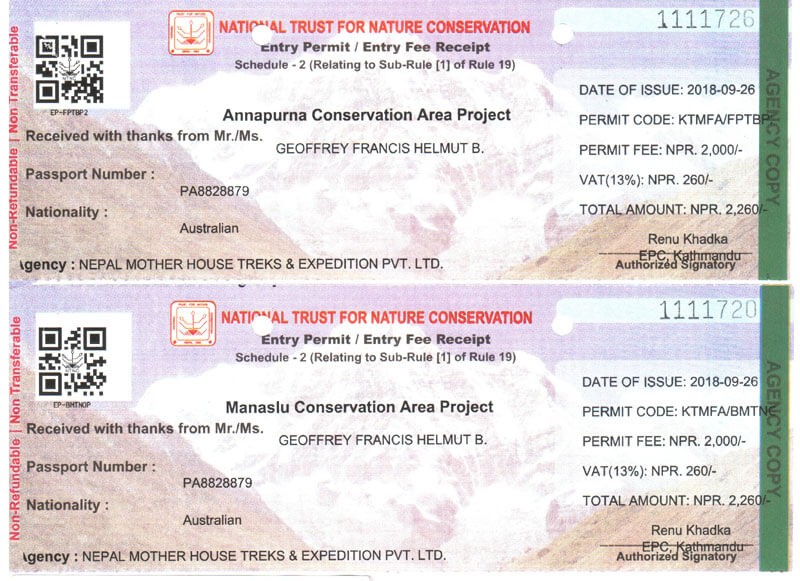
It is home to more than 39 mammals, 2000 species of plants, 201 birds, three reptiles, 11 butterflies, and various amphibians. Among them are the red panda, musk deer, snow leopard, and other animals noted as endangered mammals. On the other hand, birds such as the Himalayan Snowcock, Chukar, Himalayan Griffin, and Golden Eagles are widely accessible.
The objective of MCA is to maintain sustainable tourism, protecting the natural diversity and rich culture of the Manaslu region. It also helps in improving the living standard of local people. By the way, there are about 9,000 inhabitants in MCA.
Do I need a guide and porter for the Manaslu Trek?
Manaslu Trek is a restricted area trek, so you need special trekking permits through the authorized trekking agency of the Nepal Government. Porter is not compulsory but needs a professional guide for the Manaslu Circuit and Tsum Valley trek. The Manaslu Restricted Area starts from Jagat to the Larkya La pass. You can hire a guide and porter from an authorized trekking company or choose an agency with their client's review or friend's recommendation.
On the other hand, a guide can be helpful during the trip. The situation can get ugly while trekking in such a rural area.
What kind of accommodation is available in the Manaslu Circuit and Tsum Valley Trek?
The Manaslu Tsum Valley Trek is one of the best teahouse treks in Nepal. The routes have a standard level of accommodation services despite being in such a rural area. There are wide options to choose from for you. If you wish to go on a camping trip, it is also possible.
The ambiance and environment of the tea houses are so positive. You can meet lots of fellow travelers. You can share your story as well as listen to their story.
Tea houses have the basic required amenities and facilities. Most of them have twin bedrooms. But not all of them have an attached bathroom. Usually, rooms are clean and well-maintained with blankets and pillows. Also, the toilets are not inadequate at all.
What kind of teahouse and hotel are available in the Manaslu Circuit Route ?
The Manaslu Circuit walk is well-known as a teahouse walk, then. Mostly, you will be staying at Tea House, where you will have a good enough double or single bedroom with clean and tidy bedcovers, pillows, and blankets, and a communal bathroom.
Usually, there are comparable tea shops all along the Manaslu Circuit walk; all have neat and clean European toilets inside the house, sharing basic.
Most of the places have attached bathrooms on the entire Manaslu Circuit Route, such as in Macchakhola, Jagat,Dang, Namrung, Shyala, Samagaun, Samdo, Larkya Bazaar, Bhimtang, and Dharapani. As only a few teahouses have attached bathrooms, the number of trekkers who travel with a group won't be sufficient for all of them. People who are traveling on a private trip or in a small group of 4 to 6 people have more chance to get an attached bathroom.
You must remain at Namrung Village with a USD 50 to 70 per person per day additional charge, including breakfast, supper, tea, coffee, and lodging, if your trip's most opulent hotel is there.
Similarly, in the Dharmashala before the Larkya La Pass, there are mostly dormitory rooms because there are merely a restricted number of teahouses—only three teahouses. Here you can share a room with some other group.
The cost of accommodation varies according to the altitude of tea houses and also depends on the peak and off-seasons. At lower altitudes, it costs around $2-$5, whereas it costs $5-$10 in higher places. If you want to stay in a single room, they may charge extra.
Manaslu Trekking Tea Houses and Their Contact Number:
| S.N. | Name of Places | Altitude | Accommodation & Contact |
| 01. | Arughat Many good lodges here | 550 m |
View Manaslu Resort, Hotel Third Step, Hotel Manaslu. Tel: 9741193195 - Uday Shrestha |
| 02. | Soti Khola (or Arket), basic lodges | 720 m |
Satkar Guest House, Samjhana G.H., ABC Guest House, Tel: 064691037, 9808571935—Gorkarna Adhikari |
| 03. | Machha Khola, good lodges here | 930 m |
Hotel Tsum Valley Resort, Tel: 974605473, 06469104, 9746037107, Mount Everest Guest House, Tel: 9746047927, 9746052253, Royal Garden Guest House, Tel: 989746037107, - Pradip Gurung Hotel New Asia Trekkers Lodge. Tel: 9746061466, 9860467673-Hash Maya Gurung |
| 04. | Jagat, a good lodge (25 rooms, 50 pax) | 1440 m | Jagat Guest House, Tel: 9746053312, 9746091814, 9746078003, –Sita Karki |
| 05. | Philim, sufficient Hotels | 1570 m | Royal Garden Guest House, Tel: 064691013, 9746052691 —Sager Gurung |
| 06. | Chisapani | 1570 m | Tea House at Chisapani, Tel: 9743118188 |
| 07. | Lokpa (2 Tea Houses) | 1570 m |
Lobsang Hotel & Lodge, Tel: 994640052, 9746038100, - Lobsang Lama, New Tsum Valley Home Stay, Tel: 994640052, 9746043882—Lopsang Lama |
| 08. | Chumling, Chumchet (3 Tea houses) | 2361 m |
Tashi Delek, Tel: 9749343007, 984544046—Lobsanh Lama Tsum Ganesh Himal Hotel, Tel: 9741142261, 994640032, –Gopal Lama |
| 09. | Chhekamparo (tea houses) | 3010 m | New Milerepa Guest house, Tel: 9761502341 |
| 10. | Lar (2,3 Tea House) | 3109 m | Tsum Valley Lodge, Tel: 994640056, 9841230879—Lopsang Lama |
| 11. | Chhule Nelae (3 Tea Houses) | 3361 m | |
| 12. | Mu Gumba | 3700 m | |
| 13. | Deng, good lodge (20 rooms, 40 pax) | 1860 m | Manaslu Trekkers Home, Tel: |
| 14. | Namrung, reasonable lodges | 2560 m | Thakali hotel, Tharpu Guest House, Tel: 994640011, Tsering Bista Lama |
| 15. | Low, reasonable Hotels | 3180 m | Tashidhelek Hotel, Tel: 016925172 |
| 16. | Shyala, basic lodge (or Lho, reasonable) | 3500 m | Peak 29 Guest House Tel: 994640014-Kunsang Dorje |
| 17. | The accommodations in Samagaon are excellent. The Sama-Manaslu Basecamp excursion offers an optional rest day. | 3500 m | Samagaoun Guest House, Mt. Manaslu Hotel (tel: 993644005 Bir Bahadur Lama), Norbu Guest House. |
| 18. | Samdo, via Manaslu Basecamp, Reasonable lodges | 3800 m | Hotel Yak Hotel Twin Tibetan. Tel: 993640005 Kunsang Tsering Chez Kelsang |
| 19. | Larkye Phedi/Dharmashala, three good lodges now (60 pax) | 4600 m | Larke Rest House |
| 20. | Bimthang, good lodges | 3700 m | Hotel Pungkar, New Tibetan Guest House (993664542), Bimthang Cottage House |
| 21. | Tilje, good lodges | 2300 m | |
| 22. | Dharapani, good lodges | 2130 | New Tibet Guest House, Tel: 9746041466—Ratna Gurung |
How about food and beverages in the Manaslu Region?
The food you find in Manaslu is healthy and freshly made. They serve vegetarian food along with non-vegetarian items too. As always, try to avoid meat production, which is not a healthy option in the Himalayas.
Moreover, you can choose continental foods like pizza, spaghetti, and many more. Chowmein, Mo: Mo, veggie curry, and soups are commonly available, including some Tibetan foods. Dal Bhat is a wise choice to have in the Himalayas. It comes with a free refill. We have a quote, “Dal Bhat power, 24-hour," and we do have a reason for the output:
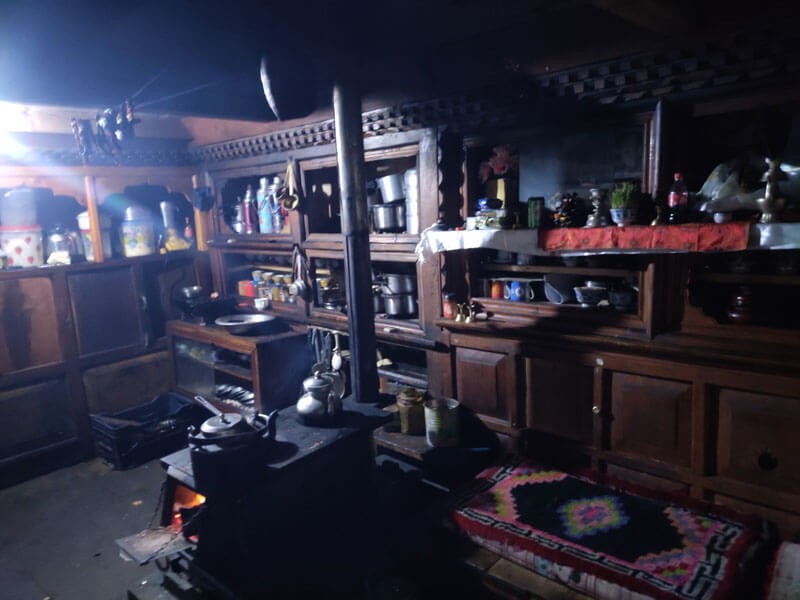
Let's dive into the beverage selection; you can choose from a wide variety of soft drinks to alcoholic drinks. Also, there is a wide variety of hot drinks to choose from. So, choose wisely and enjoy your drinks. Quick reminder: don’t forget to try the Nepali wine ‘Raksi.’.
How difficult is the Manaslu Trek?
The difficulty level of the Manaslu trek is moderate and strenuous. It isn't considered the hardest. However, the continuous ascent and descent throughout the trail can challenge your limits and endurance.
The Manaslu region presents a physically and mentally challenging trek. It is perfect for adventure seekers. A constant trekker can easily complete it without any issues.
But for beginners, it can be a challenging trek. You might need to prepare for the trek. Start doing workouts and jogging before you leave for the trek.
Moreover, the difficulty can depend upon some factors, like physical fitness, the weight you carry, the condition of the trail (snow), trekking gear and equipment, acclimatization, food choice, and so on.
How long is the Manaslu Circuit Trek with Tsum Valley?
Typically, visitors can spend a maximum of 26 days exploring both the Manaslu Circuit and Tsum Valley. It depends on trekkers whether they want to include side trips or exclude them.
Perhaps 18 days is an effortless and convenient time, but it can be too long. If you want a short Manaslu trek, then you can choose a rapid trek as well as exclude side trips, which can reduce it by up to 7 days.
If your sole goal is to conquer the Larke La pass, it will require even less time. The 14-day itinerary is perfect for the Manaslu Circuit Trek. Plus, Tsum Valley will get an additional 7 days. For your ultimate experience in Manaslu, we have Ultimate Manaslu Trekking; make sure to check it out.
Only the Tsum Valley trek is possible, too. It consists of 11 days. Similarly, one can shorten the days. Likewise, the Manaslu Circuit Trek can be done in 11 days in the shortest form.
Manaslu Circuit and Tsum Valley Trek Itinerary.
Below, we have provided an outline of the Manaslu Circuit and Tsum Valley itinerary. We designed it to avoid road construction. You can go directly to Machha Khola and then trek to Dobhan or Jagat. Here, we have a day-to-day itinerary:
Manaslu and Tsum Valley Trek Suggested Itinerary: -18 Days
Day 00: Arrival at Kathmandu.
Day 00: Trekking preparation and permit paperwork day.
Day 01: Drive from Kathmandu to Machhakhola (930 m) via Gorkha and Arughat Bazaar (535 m) - 9 to 10 Hours
Day 02: Trek Machha Khola to Jagat (1,340 m) - 5 to 6 Hours
*Note: Now you can drive in a single day from Kathmandu to Jagat also. Which will save one day for your trek.
Day 03: Trek Jagat to Lokpa (2,240 m) - 5 to 6 Hours (Enter in Tsum Valley Restricted Area)
Day 04: Trek Lokpa to Chumling (Lower Tsum) (2,361 m)—4 to 5 Hours
Day 05: Trek Chumling to Chhekampar (Upper Tsum) (3,010 m) - 5 to 6 Hours
Day 06: Trek Chhekampar to Chhule-Nile (3,361 m), visit Milarepa Piren Phu Cave (6 to 7 hours)
Day 07: Visit Mu Gompa (3,700 m) from Trek Chhule-Nile, visit Dhephyudonma Gompa (4,060 m) for 3 to 4 hours, & back to Rachen Gompa (3,210 m) for 2 to 3 Hours
Day 08: Trek Rachen Gompa to Chumling (2,361 m) Rimchet (2,470 m) - 6 to 7 Hours
Day 09:Trek Chumling/Rimchet to Pewa (1765 m)/Deng (1865 m)—7 to 8 Hours @ 7 Days
Day 10: Trek Pewa/Deng to Ghap (2165 m) 5 to 6 Hours
Day 11: Trek Ghap to Lho (3180 m)—5 to 6 Hours
Day 12: Trek Lho to Shyala (3,500 m) – 2 to 3 Hours visit Phungen Gumba (3,870 m) for 2 to 3 Hours one way and back to Shyala
Day 13: Trek Shyala to Sama Gaon (Ro) (3,525 m) – 1 ½ to 2 hours, then visit Manaslu Base Camp (4,400 m), Birendra Lake
Day 14: Trek Sama Gaun to Samdo (3850 m): 4 to 5 hours
Day 15: Trek Samdo to Dharamsala (Larkya) Phedi (4460 m): 5 to 6 Hours
Day 16: Trek Dharamsala/Larkey Phadi to Bimtang (3590 m) via Larkya La (5,160 m) 7 to 8 Hours @ 7 Days
Day 17: Trek Bhimtang to Dharapani (2,130 m) via Tilje (2,300 m): 7 to 8 Hours
Day 18: Drive to Besisahar (825 m) Day 18: Drive to Besisahar (825 m). -5 to 6 hours
Day 00: Your destination.
**Note: (Except restricted area) Date: Talk to your guide about itinerary changes during the trek. The itinerary is flexible according to your requirements.
*Manaslu Circuit and Tsum Valley Trek Map.
The map presented below is designed according to the itinerary programmed above:
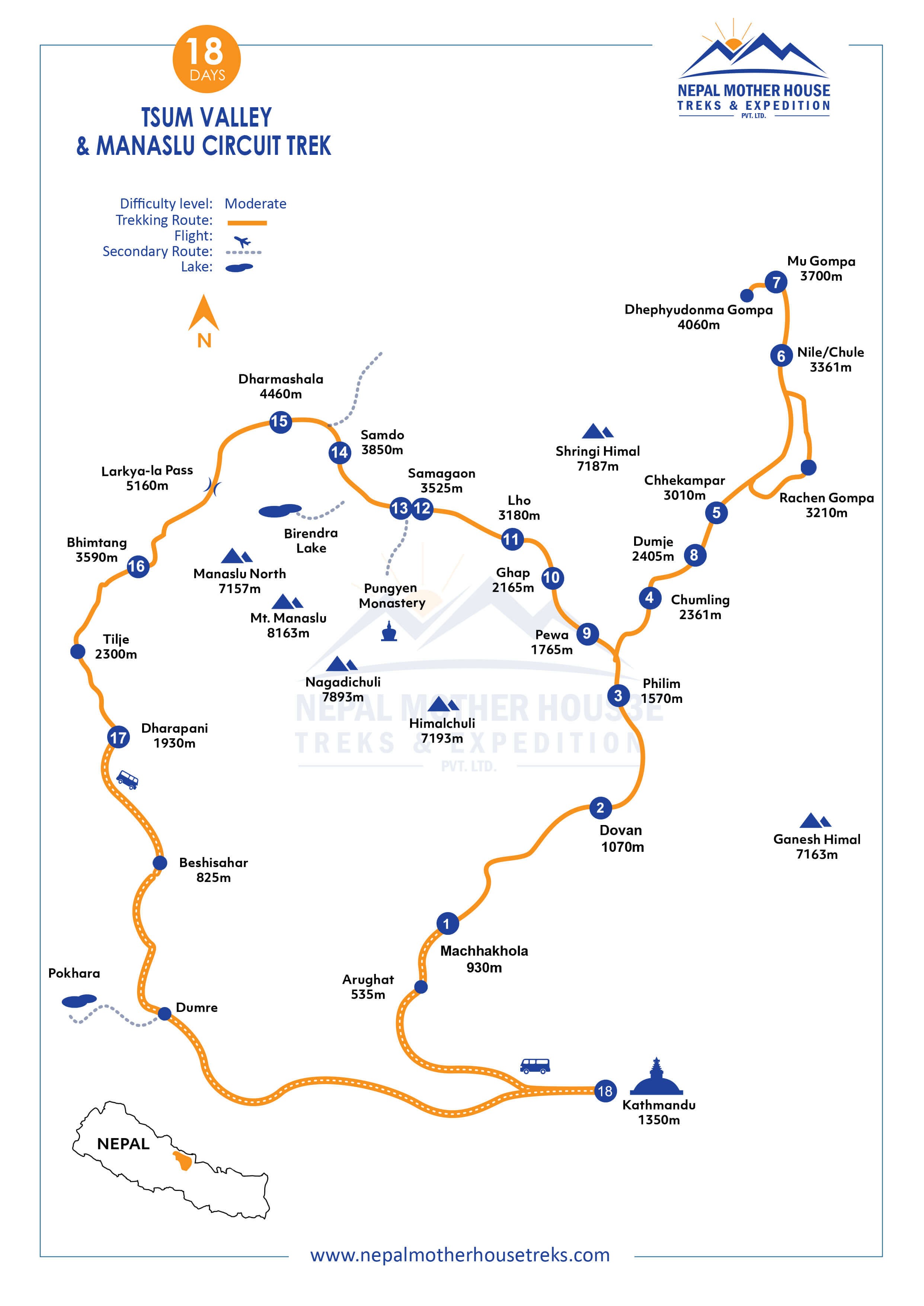
The article provides details about the elevation of the Manaslu region.
Similarly, the map above presents the elevation as follows:
This is a brief trek along the Manaslu Circuit.
The Short Manaslu Circuit Trek aims to explore the trekking routes of Manaslu within a brief timeframe. Those who are mentally and physically prepared for the high Himalayas in 11 days are the target audience.
Short treks are best to avoid long days. Also, it gives opportunities to visit more places in a short time. But it will be more challenging than the regular trek. You have to walk more in a single day. Beginners should avoid it.
The Sacred Tsum Valley and its Facts
Even if people are not drinking alcohol, every house stores alcohol the whole year to serve the guests. Human life necessitates alcohol for everything from birth ceremonies to funerals and even beyond all festivals, such as Puja. Every year, when someone falls ill, relatives also bring alcohol to comfort them.
Tsum Valley has the sinoname of Saga (Non-Violence)
In this sacred valley, you cannot kill or sacrifice animals or fire in the jungle. If an individual inadvertently ignites a fire in the jungle, the village community will impose a penalty of Rs. 50,000.00, leading to the death or harm of numerous creatures such as insects, grasshoppers, mice, birds, and other animals. The accused individual is required to offer 108 oil lights (Diyo) in the monastery as an apology for this unknown mistake and to make a vow not to repeat the mistake in the future. Some trekkers have to be careful while visiting the sacred Tsum Valley. If you are a segregated lover, be careful after smoking with fire.
There is no way to kill animals at Tsum Valley, although there is no bar to eating meat.
Kill animal is strictly provided in the region; however, some people are having meat that is carried from downtown. Accidentally dead animals like yaks and goats while grazing in the pasture, falling from the cliff, and any other accident are also eatable.
Likewise, Tsum Valley is provided:
- To Keep the Honey Bee
- To keep the Chicken farm
- No Violence, No shelter animal
- No firing in the Jungle
People's culture and Lifestyle till 2009 in Tsum Valley
Tsum Valley has been open since 2009 for foreign tourists. Hidden in the shadow of the lamp, Tsum Valley holds immense tourism potential. Given its proximity to the Tibet-China border, this trek operates as a restricted area, subject to specific rules and regulations. The remote Himalayan location has isolated people from the outside world. People only wash their heads once a week and bathe their entire bodies once a year during the special Losar (New Year) season. Nature is so kind to take care of everybody's health.
Farming and animal husbandry were the main occupations of the Tsum Valley before tourism flourished.
The valley's primary crops, potatoes, wheat, barley, buckwheat, and mustard, are grown only once a year, along with livestock such as yaks, horses, and sheep.
They grow barley and wheat regularly for three years and, after that, buckwheat or mustard for one year. Likewise, the group planting cycle is running further.
Yeks Header and his salary
There is a certain herder, one or a few, who takes care of his animals and all of the towns. He grazes the cattle in the pasture lane, brings them home, and protects them the whole year. The villagers provide a specific amount of grain, such as wheat, barley, potatoes, rice, or any other grain, to the caretakers of the cattle.
Ancient Buddhists handwrote the Grantha with gold and silver sculpture
Gold and silver handwritten sculptures and precious holy books can be found in the Tsum Valley, specifically in the house of Tashai Tundup. Due to safety concerns, not everyone has access to this precious book. This is a sacred book that only a key person can access.
Tsum Valley is an open museum for thermals and culture.
People here are Tsumba; their culture is similar to the Tibetan people, and they follow Buddhism. There are century-old monasteries, Chhorten, Mane Wall, and Buddhiost, carving rock and stone.
What’s the difference between the Manaslu Circuit and Tsum Valley?
Manaslu Circuit and Tsum Valley share the same entry point and exhibit correlation. However, they possess distinct characteristics and components. We have provided some of the differences in the table below:
| Manaslu Circuit | Tsum Valley |
| Tea houses are pretty standard and are more touristy. | The family is in charge of running decent tea houses. |
| There are a variety of ethnic groups living there. The family is in charge of running decent teahouse groups. | It is the home of the native Tsumba people. |
| The highest elevation is 5,106 m, which is Larke La pass | The highest elevation is 3,700 m, which is Mu Gumpa. |
| The starting and ending points are different. | The starting and ending points are the same. |
| The trail is challenging. | The trail is easier than the circuit. |
| The area is significantly busier due to the large number of tourists. | It has fewer tourists than the circuit. |
There is WiFi and network connectivity in the Manaslu area.
It might be surprising that the Manaslu area has Wi-Fi as well as network connectivity. Get in touch with loved ones even in the Himalayas.
Talking about WiFi, in Tsum Valley, only Lokpa has WiFi access, which is the starting point of the valley. Afterward, you cannot connect to the world but can enjoy the tranquility of nature. However, in Circuit, almost every location, except Dharmasala, has WiFi, as do some other locations.
The WiFi you get below Lho is pretty good. But from Lho and above, you will find satellite Wi-Fi, which works only from 7 am to 7 pm. Also, when the weather is worse, it might not work. After crossing Larke La, you can enjoy Wi-Fi there too.
Thanks to Nepal Telecom, a mobile network is possible in the Manaslu region. They completed the project at the beginning of the year 2022. Now, you can stay connected and use cellular data, too.
Is electricity available in the Manaslu Circuit Trek?
Yes, electricity is available in every place in the Manaslu region. But just a few years ago, the majority of the region had to depend on solar power. To provide electricity, the Nepali government built Budi Gandaki and Mini Hydropower.
In the past, when there was only solar power available, you had to pay to charge electric devices such as mobile phones, power banks, and batteries. Nowadays, you can find an electric socket in your tea house’s room, and it's free, too.
Transportation to the Manaslu Circuit and Tsum Valley. How do I get there?
Transportation in the Manaslu region is a big question because it has been a long time since road construction started. Before, the road access had just reached Arughat. Then, the trek has to start from there.
But now, the road access has reached Jagat, Chumnumbri Rural Municipality, near Philim Village (which is a couple of days away from Arughat). Still, transportation is available to Machhakhola. If you reserve a private Jeep, it can drive to Jagat.
The only way to reach Manaslu is by road. You either go by public bus from New Buspark at Kathmandu or reserve a private jeep. Three buses depart at 6 to 8 AM every day; it takes about 6 to 7 hours to reach Arughat by public bus. Afterward, you need to take another bus/jeep from Arughat to Soti Khola or Machhakhola. It will take another 2-3 hours again. There are three bus services from Kathmandu to Machhakhola directly through the historical town of Gorkha Bazaar, so it takes 2 hours longer to get there in total.
Despite being the most comfortable and time-saving option, a private jeep is significantly more expensive than public transportation. The cost of the private Jeep is USD 200 to 250, which seven people can accommodate.
Where can I buy Arughat Bazzar and Machhakhola bus tickets in Kathmandu?
Well, you can buy Arughat Bazaar and Machhkholabus tickets from New Bust Park at Gangabu, Kathmandu. There are three buses that depart from Kathmandu to Arughat bazaar every day. The first bus departs in the morning at 6:00 AM, and others are 7:00 AM, 8:00 AM, and 11:00 AM. It goes through the Prithvi Highway about 70.4 km, about a two-and-a-half-hour drive, then crosses the Trishuli River bridge to the Dhading Besi (headquarters of the Dhading) and then heads to the Arughat bazaar, mostly on blacktopped roads.
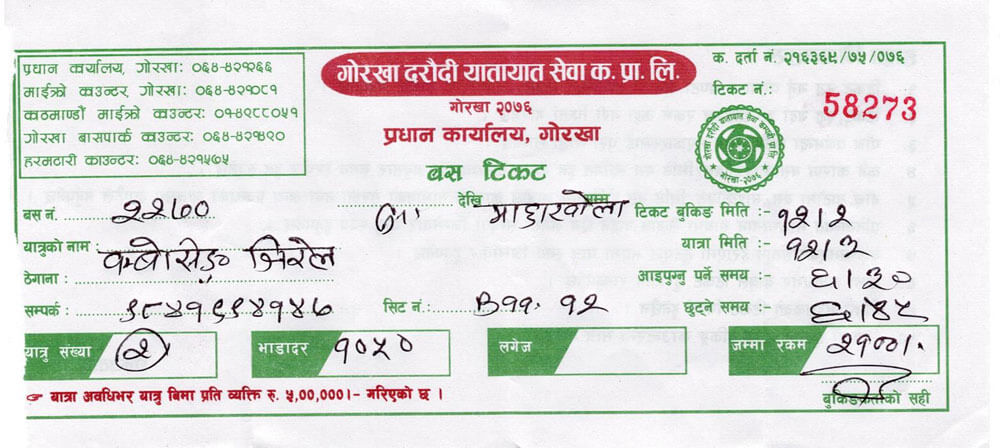
When you get in Arughat Bazaar, then you need to change to another bus/jeep to Machhakhola (930m) about 2 ½ to 3 hours through the rough road adventure along the Budhi Gandaki River bank. Sometimes, you need to wait for the bus until it is full. But if you are in a group of 6 to 7 people or ready to pay some extra money, then you can drive immediately when you get to Arughat Bazaar also.
How long does it take from Kathmandu to Arughat Bazaar?
Normally, the drive from Kathmandu to Arughat Bazaar (535m) takes 6 to 7 hours, mostly through the blacktop road. However, sometimes it may take longer than expected depending on road conditions like traffic jams, landslides, floods, or road construction. It is suggested that you put in some extra time to get into Arughat Bazaar in case anything happens unusually. Here is the contact number for the bus tickets to Arughat Bazaar.
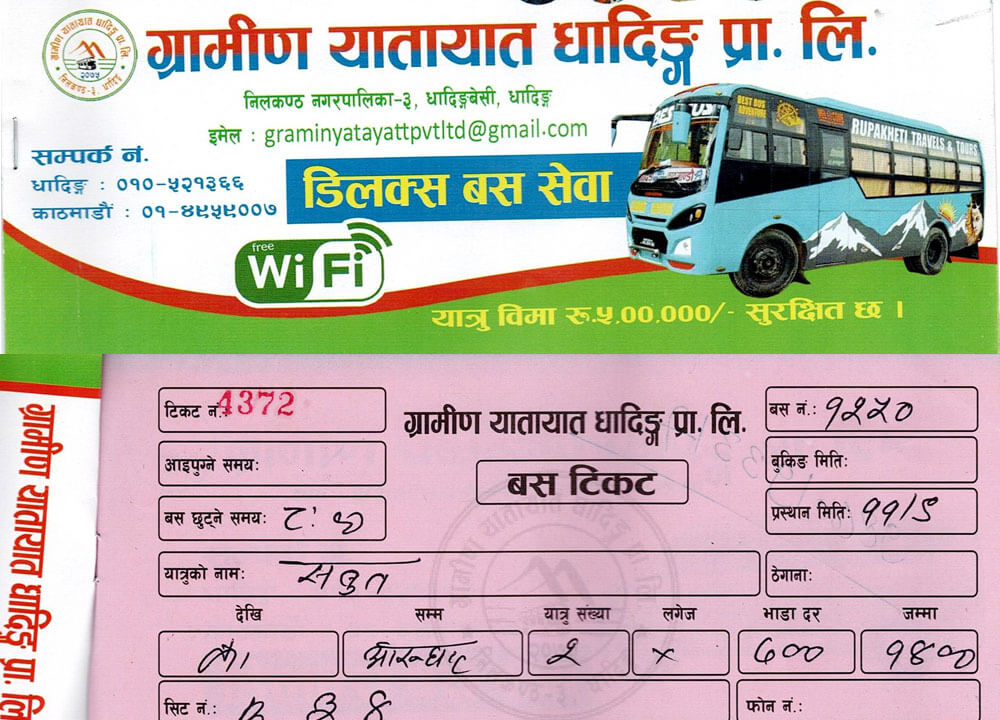
Is there a direct bus available from Kathmandu to Machhkhola?
Yes! There were two buses (day and night shift) available to drive directly from Kathmandu to Machhkhola. The day bus used to leave at 4:45 AM in the morning from Kathmandu; you need to be in the bus station 15 minutes before departure at 6:30 AM. Likewise, the night shift bus leaves at 5 PM. The buses go through the Gorkhao Bazaar. But currently (31 March 2025), there is not any direct bus available to Machhakhola. You need to drive from Kathmandu to Arughat Bazaar and then take another jeep/bus to Machhakhola.
I heard the deluxe bus; is there a Dekux nonstop bus available from Kathmandu to Arughat Bazaar?
Yes! There is a deluxe bus available from Kathmandu to Arughat Bazaar every day. The deluxe one departs at eight o'clock in the morning from the Kathmandu bus station. Delux is a nonstop coach, except for toilet breaks and lunch breaks, driving directly from Kathmandu to Arughat bazaar with much more comfort. Other buses are often stopped on the route, taking passengers to get in and get up. But the deluxe takes only direct passengers to Arughat bazaar. As a result, the deluxe bus got into Arughat Bazaar faster than the first bus, which leaves from Kathmandu at 6:00 AM.
If you are looking for a much more comfortable drive, then you may hire a private jeep to Machhakhola at a cost of about US$ 200 to 250 for a jeep.
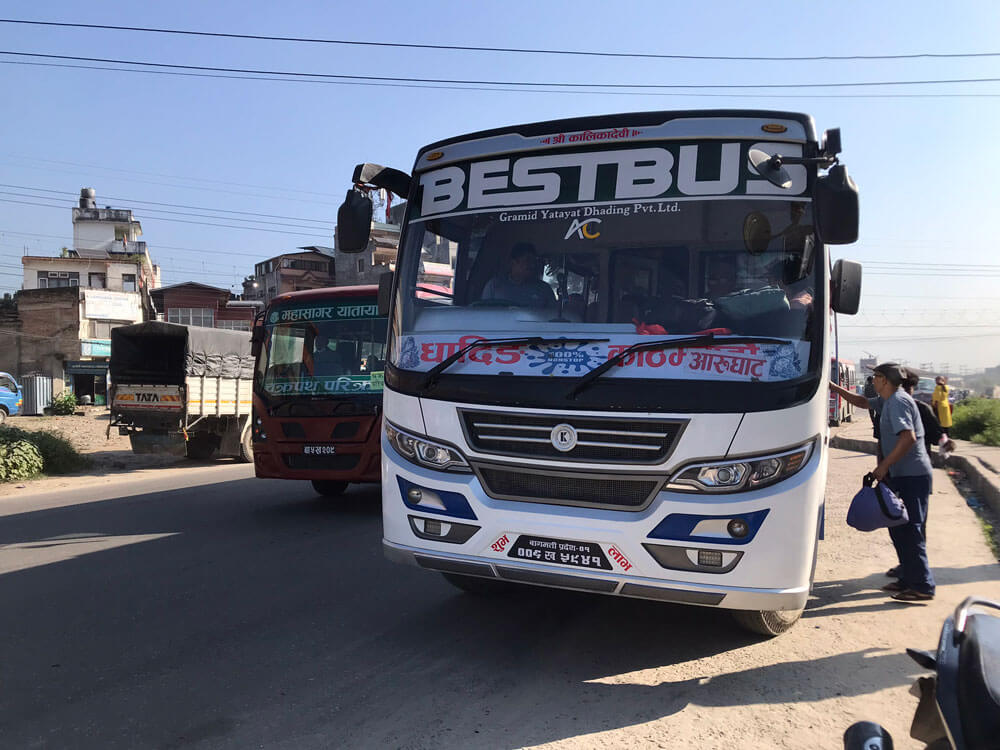
How often can we get a bus from Arughat to Machhakhola?
Well, Corently (31 March 2025), there are three buses to Machhakhola from Arughat Bazaar. The first bus goes at 10:00 AM, the second departs at 2:15 PM, and the third bus departs at 3:30 PM. However, this can change according to passenger flow and demand. You can hire a private Jeep from Arughat to Machhakhola also.
Can I drive from Kathmandu to Jagat in one day? And how much does it cost from Machhakhola to Jagat?
You can drive from Kathmandu to Jagat in a day. But the road is under construction; you must depart from Machkhhalola before5:00 PM. After five, it is not allowed to drive to Jagat due to road work.
Regarding the Jeep cost, it depends on private and shared jeeps. Mostly, you can get a shared jeep to Jagat, which is much cheaper for 2 to 3 passengers. The sharing jeep cost to Jagat is NPR 1,000 to 1,200 per person, roughly, and a private jeep (Tata Sumo/Bolero) from Machhakhola to Jagat is about Rs. 7,000 to 9,000 per private jeep.
Has road construction affected the trekking trail?
To be honest, road construction has not affected the trekking trail yet. However, the road will eventually reach Rui La Pass. But the construction has avoided the main trekking trail. You can still enjoy the virgin trail of the Manaslu region.
There are many routes to escape road construction. Are you interested in discovering new trails in Manaslu? Give some time to check them out.
Manaslu Circuit and Tsum Valley Trek Route: Other Alternative Routes.
Normally, the Manaslu Circuit and Tsum Valley start from Arughat. Then, the trail follows through the Soti Khola. Afterward, it will lead to Jagat, the gateway of the Manaslu region. However, there are alternative routes available.
As you enter the Manaslu region, the trail passes through Philim, following the trail alongside Budi Gandaki. The village has one of the biggest settlements. After a few hours of walking from the village, you will reach the suspension bridge. Cross the bridge to reach Circuit, then follow the path to reach Tsum Vall.
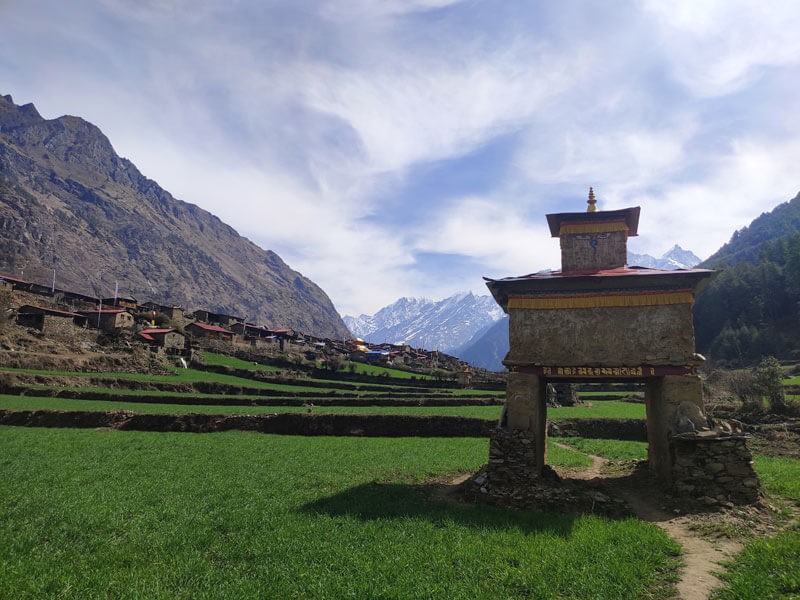
Are you prepared to explore alternative routes? There is another way to join the trail through Ballpark Village. It will add a couple of days to your normal itinerary. However, the journey through that village will prove to be worthwhile. It shares one of the best skyline views of the Manaslu range.
Or are you done with the teahouse trek? Are you seeking a fresh experience? The Bhumlichok Bhairabi Homestay Trip can be an ideal choice. This trip will show what Lower Manaslu is about.
How about altitude sickness in Manaslu?
Of course! You should be concerned about altitude sickness because you will be over 5,000 meters above sea level. It is not a rare case to have altitude sickness on the Manaslu trek. But we can avoid it through many remedies.
First, you should know the symptoms of altitude sickness. Remember, the symptoms can range from normal to critical. The symptoms include headache, loss of appetite, shortness of breath, tiredness, dizziness, and others. If your condition deteriorates, you require immediate medical attention.
There are many remedies to prevent altitude sickness. Always eat properly with a heavy diet. Make sure to stay hydrated all the time. Avoid alcohol at higher elevations. Take your pace and ascend slowly. Take it gently and mentally prepare for the challenges.
Manaslu Trekking Guide: Visit the Sacred Sites in Manaslu Region
A trek in Manaslu does not only see the snowcapped mountains but also observes the local culture and tradition in the lap of the beautiful Himalayas. During your trek in Manaslu, you will visit some of the best sacred sites, like Mugumba, Rachen Gumba, Milerepa Cave Monastery, Gumba Lungdain in the Tsum area, Serang Gumba, Kalmochhan Tal hike from Prok village, Hinnang Gumba, Himalchuli Base Camp, Pung Gyen Gumba, and Samagaun is the birthplace of (Nubri Valley) Guru Mingyur Rinpoche "The Joy of Living" Book, Milerepa Cave in Samagaun, and Rula Pass (border to Tibet-China) as a side trip in Manaslu. The Himalaya takes you into automatic meditation mode during the trek; you will feel your body language and spiritual vibe after the trek and before. Find out for yourself who you are. And why are you? as a human being by self-realization.
Visit the Manaslu Base Camp while trekking.
Manaslu Base Camp is the campsite below Mt. Manaslu, where the climbers stay before ascending to the summit. Located at a height of 4,800 meters, it has been a favorite spot for hikers to acclimatize well.
It has only access from Samagaun. When trekkers stay an extra day in Samagaun, they prefer to hike at higher altitudes for acclimatization. The Manaslu Circuit Trek also incorporates this route. It takes 4-5 hours to ascend through the Birendra Lake and an additional 3-4 hours to descend back.
It takes a whole day to explore Manaslu Base Camp. So, you need to pack lunch from the tea house where you stay. You can enjoy the Manaslu-efficient view while preparing your lunch. Best Side Trips: Acclimatization in the Manaslu Trek.
Both the Manaslu Circuit and Tsum Valley have numerous side trips with rewarding views and are adventurous. Side trips are beneficial for acclimatization. If you choose to travel on all side trips in one trek, then you will need a month of holiday.
There are several hidden treasures in the Manaslu region. Only a few people go to this unspoiled area. It may be your chance to explore the untouched beauty of Manaslu.
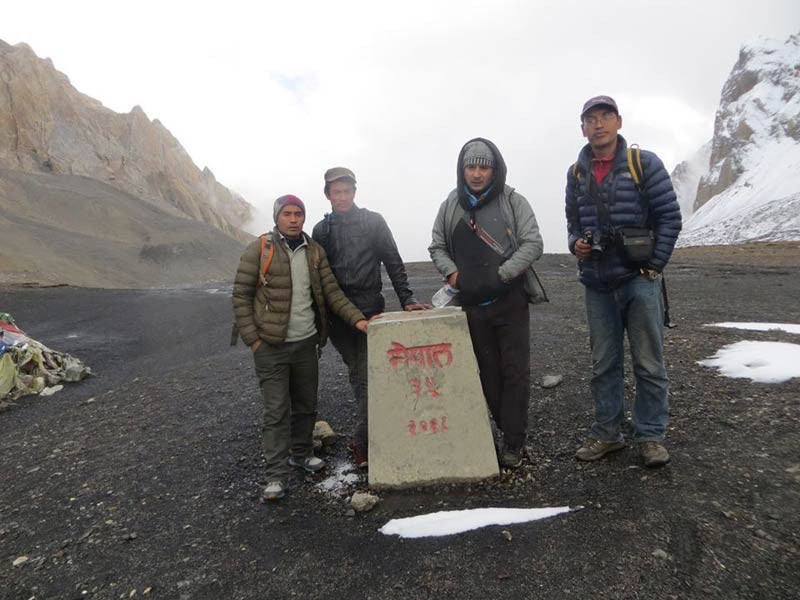
Namely, combine the Manaslu Circuit Trek with Serang Gumba, Kal Tal (lake), Hining Gumba, Himalchuli Base Camp, Pungyen Gomba, Manaslu Base Camp, Milarepa Cave (3750 m), Rui La Pass, Serang Gumba, Birendra Lake, Ponkar Lake, and Milarepa Cave, and Danda (ridge) are located in the Manaslu Circuit side trips. Manaslu Base Camp is famous among tourists due to an additional rest day in Samagaun.
Likewise, Tsum Valley has a lot to offer, like Mu Gumpa, Dhephyudonma Gompa, Rachen Gompa, Milarepa Cave, Gomba Lungdang, Rimchet village, and Chumchet village. You should not miss them on your visit to Tsum Valley.
I have prepared packing lists for the Manaslu Circuit and Tsum Valley trek.
The Manaslu Circuit with Tsum Valley Trek is a long trek, so you need to pack your essentials as required. Let's make it short. We have made a list of gear and equipment for your convenience.
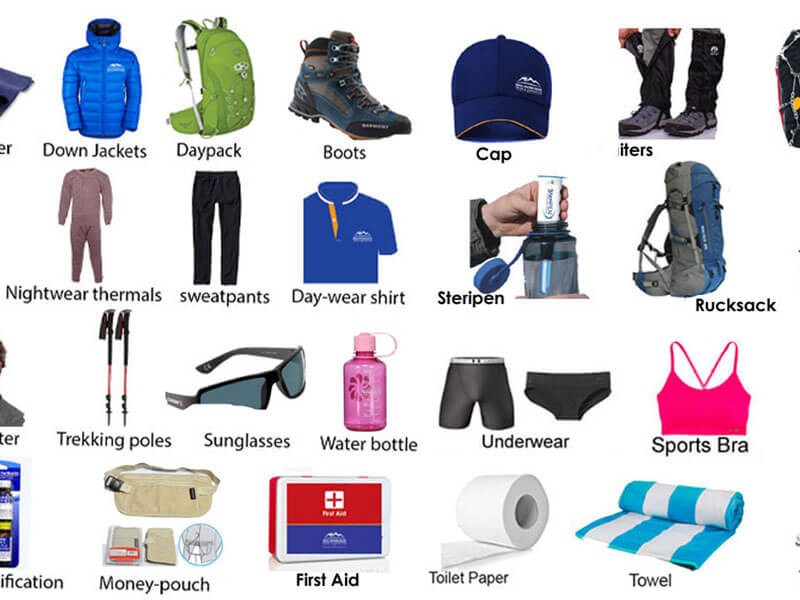
Clothing
● Brimmed hat or cap
● Neck buff or bandana
● Warm hat
● Down jacket
● Windcheater
● Rain jacket or raincoat
● Gloves (inner and outer)
● Inner thermal wear
● T-shirts
● Sports bra (for women)
● Hiking pants
● Hiking boots
● Gaiters
● Hiking Socks
● Undergarments
Travel Equipment and Accessories
● Sunglasses or Goggles
● Trekking poles
● Headlamps
● Sleeping Bag
● Backpack (30 L-50 L)
● Crampons or Microspikes
● Water bottles
Miscellaneous Items
● Water filter
● Portable charger/power
● USB type C adapter
● Multi-tool
● Portable Solar Charger
● Hand sanitizer
● Camera
● Games like chess, cards, etc.
● Snacks/Dry fruits/Chocolate
● First-Aid kit
● Medications
Toiletries
● Toothbrush and toothpaste
● Toilet paper
● Soap and shampoo
● Detergent
● Moisturizer cream
● Tampons and Sanitary pads (for women)
● Sunblock cream
● Quick Dryer towel
● Nail Clippers
We have a comprehensive guide on what to pack for a trip to Nepal. It will be helpful for you.
Note: You almost need everything mentioned above. But don’t overdo it. It may make your backpack heavy, so pack your bag wisely.
What has changed after the COVID-19 pandemic?
A lot has changed since the COVID-19 pandemic. The pandemic lasted for almost 2 years. Now, I believe time is really powerful. The area has developed way more than before the pandemic.
Previously, electricity was unavailable in nearly every region. All of them depend on solar power. Now, only a few places, like Deng and Dharmasala, depend on solar power. Additionally, Tsum Valley has constructed multiple mini-hydros.
In the meantime, owners were busy renovating their tea houses. Now, tea houses have increased their standard. Now, they provide Wi-Fi and a shower, along with an attached toilet.
Now, Nepal Telecom (NTC) has made network connections on many parts of the route. Previously, establishing connections with others was challenging.
The cantilever bridge between Dovan and Jagat is out of order. The road has reached Chhekamparo from Tibet, but the road is not in good condition. Locals say there are no public vehicles, but some farmers use the road for tractors.
How to Choose the Right Travel Agency for Your Guide to Manaslu?
It is compulsory to take a trekking guide to trek inside the Manaslu area. So, choosing the right travel agency can be tough. Choosing the wrong agency can ruin your vacation.
First of all, always watch reviews about the agency on Google or TripAdvisor. Make sure they reply to your inquiry on time, and the answer they give is precise. Don’t forget to check their website. Also, check if the photos they upload are genuine or not.
You can't miss the opportunity to embark on the journey of your life. So, Nepal Mother House is for you. We have been providing exclusive services for more than 10 years. We can proudly say our president is from Gorkha, the home of Manaslu. Additionally, all of our guides hold certifications and have completed the route numerous times.
Travel Responsibility While Trekking in Manaslu
Responsible travel involves demonstrating respect and kindness towards people, culture, and natural habitats while also promoting local tourism. The main ambition is to make the world a better place to live and a better place to visit. There are some travel responsibilities you should know before traveling to the Manaslu region.
As soon as you enter the trekking area, people will welcome you with etiquette. Never forget to say ‘Namaste’ to local people. Be careful; the excellent hospitality might spoil you. Again, don’t say ‘no’ to whatever they offer to you. Respect your guide and porters, too.
Always ask for permission before taking a picture of a particular person. Walk from the left side while crossing Stupa, Chhorten, and Mane. Try to use your right hand because it is considered an acceptable manner in Nepal.
There will be children asking for chocolates. Giving them candy can be a thoughtful gesture. But don’t spoil them by giving them money.
Avoid using plastic materials. Bring your water bottles. Try not to waste food because it is very valuable in the Himalayas. Learn the local language and try to communicate with the people there. And finally, don’t complain about the facilities; that’s the best they can provide in such a rural area.
Key Advice for the Manaslu Circuit Trek
"Manaslu Circuit Trek: A Remarkable Himalayan Journey"
Rounding the world's eighth-highest mountain, Mt. Manaslu (8,163m), the Manaslu Circuit Trek is a breathtaking high-altitude experience. From rich lowlands to high mountain passes, this walk provides an amazing combination of distant culture, rough beauty, and varied scenery.
Essentials and Electricity Along the Manaslu Circuit
Among the main benefits of the Manaslu Circuit is that every settlement along the path has access to power save for Dharamsala, the last halt before traversing the stunning Larkya La Pass (5,106m). There are no charging options here, hence hikers are recommended to charge all electronics in advance or consult with you portable slower charger or power bank.
Likewise, don't stress about running out of necessities. Various stores and guesthousesalong the Manaslu path allow you to restock AA/AAA batteries as well as soap, shampoo, toilet paper, and more. This ensures stress-free and lighter packing.
Advice on Trip Planning
Understand the Road Segments
- Some parts of the Manaslu Circuit currently coincide with uneven roads, particularly between: Arughat to Macha Khola at the beginning of the Manaslu Trek.
- Machhakhola to Jagat a Jeep service accessible during excellent weather, although the road could be closed because rain.
- Dharapani from Gowa-Tilje at the conclusion of Manslu Circuit hike.
Should you choose to skip these road hikes, we advise starting with a jeep to Macha Khola or Jagat and from Gowa-Tilje to at the end of treip and Dharapani to Koto if keep countinue to Nar Phu valley trek or AnnapurnaCircuit.
Pack Wisely: 20kg 25 Kg waight Limit for Porter
Please keep your duffel bag/rucksack to 20kg to 25 Kgmax to help sustainable tourism and prevent porters being overworked. Should you plan to divide a porter between two hikers, each of you should pack 10 kg. On top, the porter has his personal 4 to 5 kg gear. Your sleeping bag and down jacket rentalweights will be given in advance, allowing you to organize the remainder of your equipment appropriately.
Your hotel or trekking agency also provides weighing scales; most visitors find this useful since it guarantees you are well-prepared without over packing.
On the Trail: Comforts & Guesthouse Tips
We closely cooperate with nearby guesthouses to offer a pleasant experience:
We urge every guesthouse to have nails in walls or hooks on doors for hanging towels, jackets, or wet things. After a long day of hiking, this tiny touch has a significant impact. Some tea Houses rooms, meanwhile, lack those door hooks or wall pegs for hanging damp clothing or towels. Should you be able to carry any portable items with you, that would be ideal.
Food Servings: Often quite generous, the lunches along the Manaslu Circuit are robust. Especially for the Dalbhat, can get until full of stomach. We're urging visitors not to squander the food since it could be of great help to other impoverished individuals.
Discover Manaslu's Magic
The Manaslu Circuit Trek is a unique experience with less people than Everest or Annapurna and a strong link to Tibetan culture. Every step tells a narrative from high mountain passes to hanging glaciers to terraced hillsides to roaring rivers. With the correct logistics, packing advice, and assistance to make your Himalayan journey really smooth and unique, let us help you organize your walk.
Conclusion
The Manaslu Circuit and Tsum Valley Trek take you to the pristine trail around the 8th highest mountain along with the hidden valley of Tsum. It is the trip you should choose for a lifetime experience. However, if you do not prepare adequately, the experience may fall short of your expectations. I hope this blog was helpful before you approached the Manaslu trek.
Was this blog helpful? Let us know. We're happy to answer your Manaslu Tsum Valley Trek questions.
